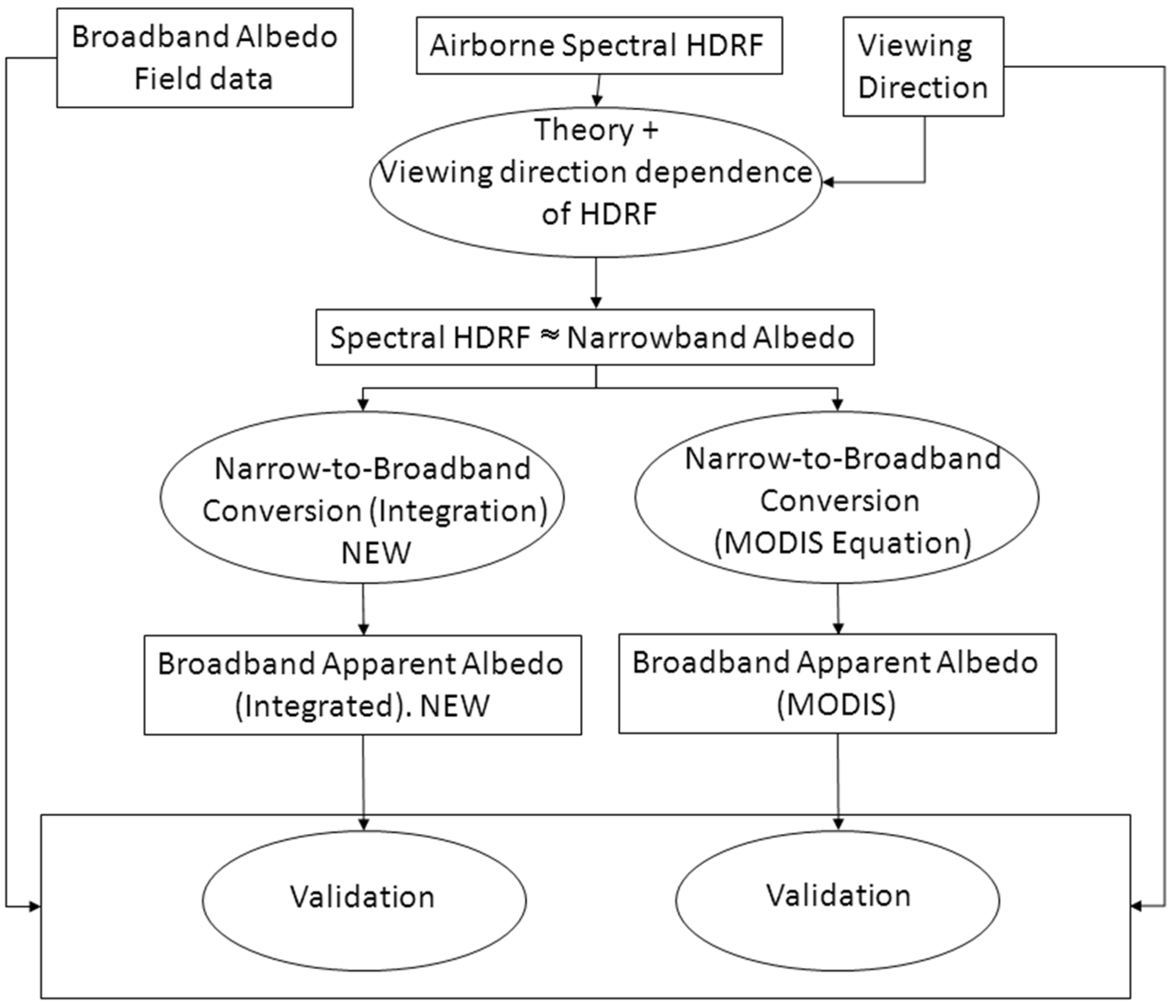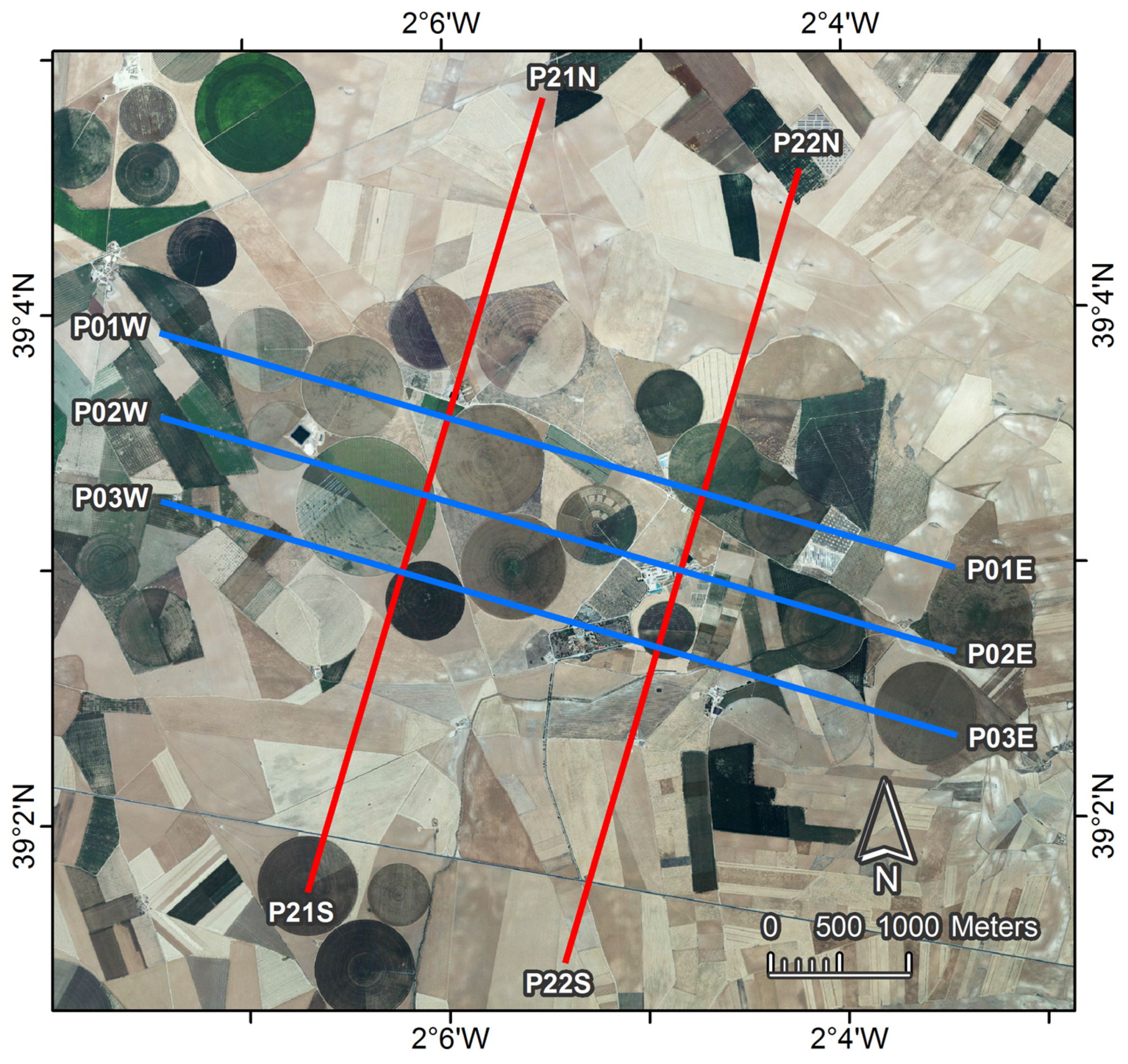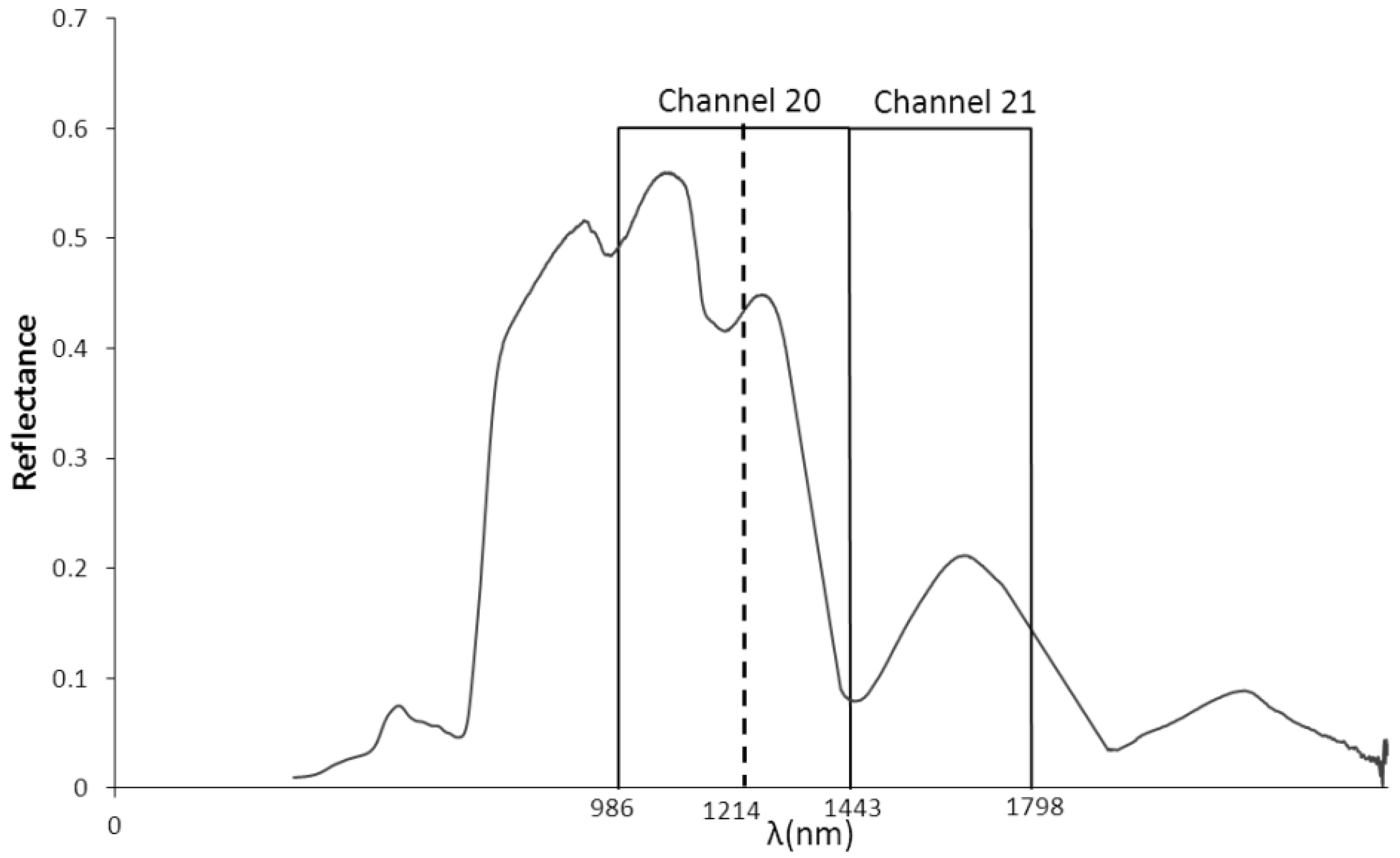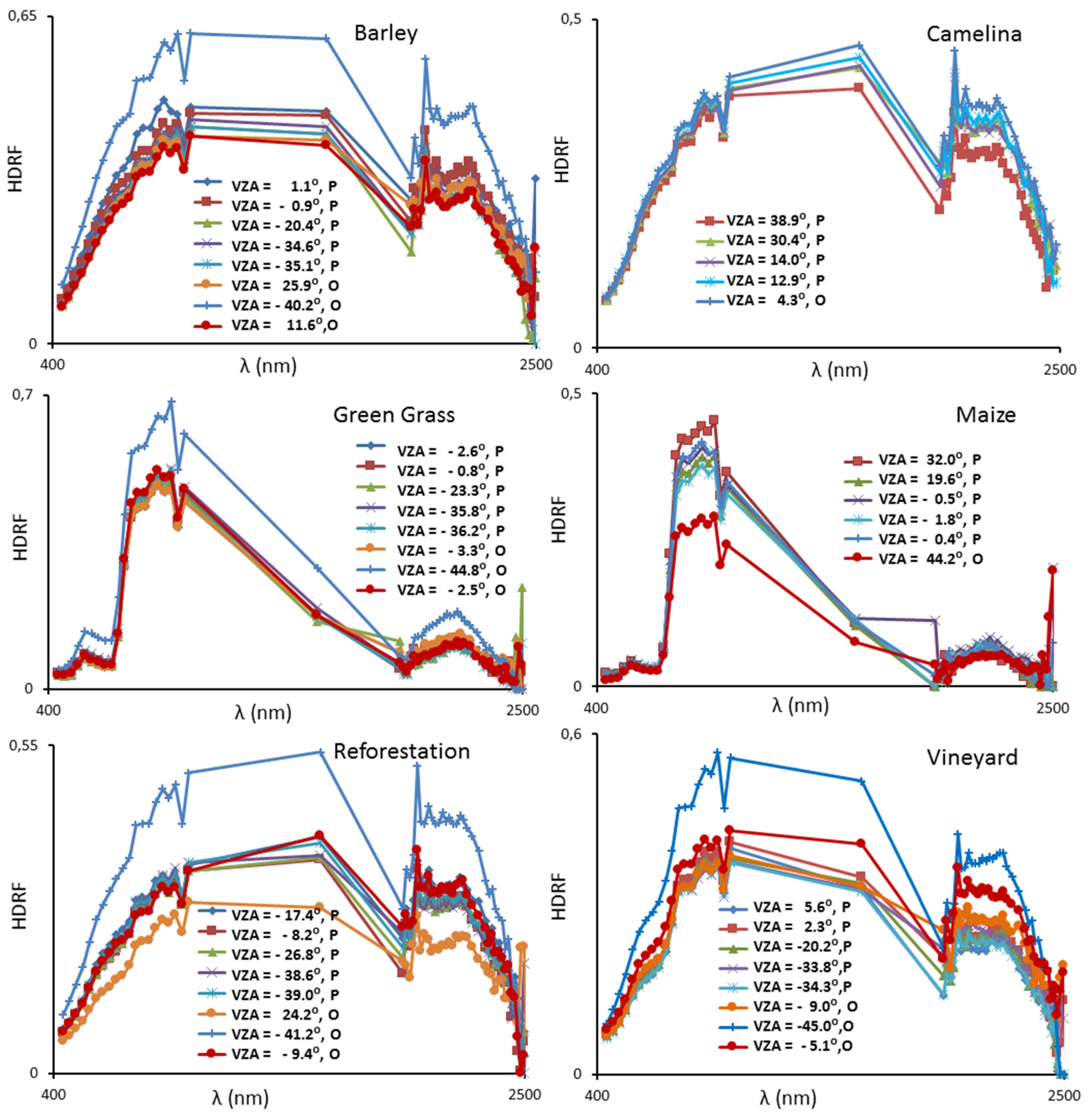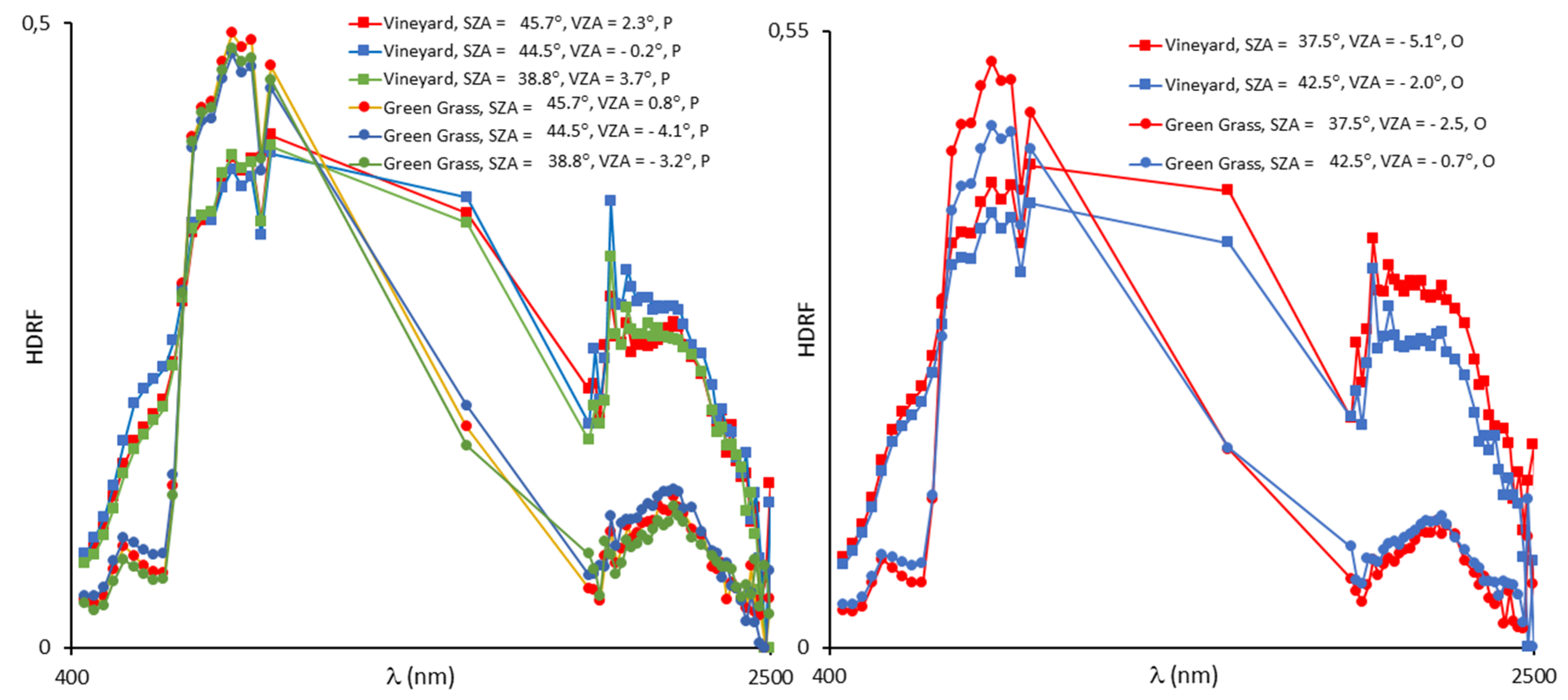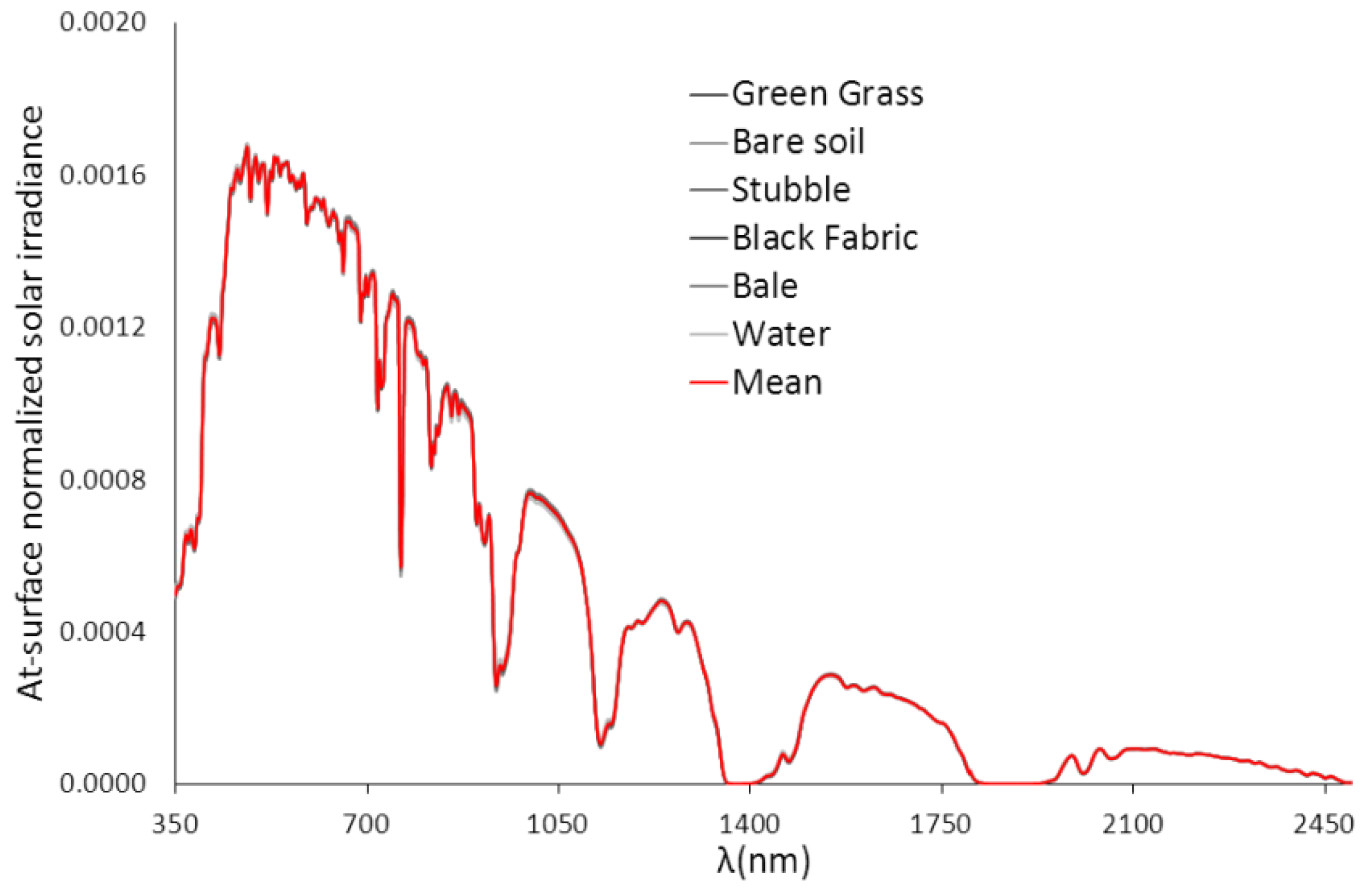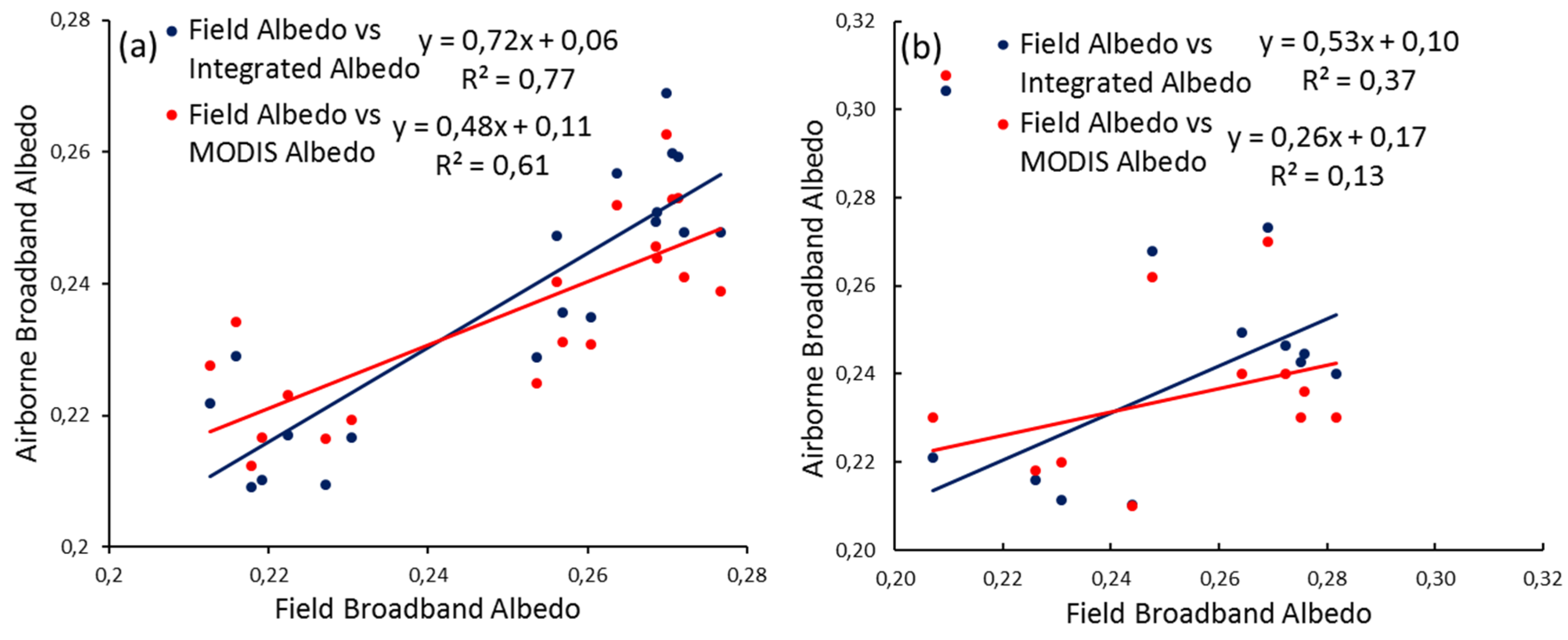In this section, we present the field albedo data obtained at each of the sites as well as the results of the parameterization used to calculate the albedo exactly at the time of each flight. We also show the dependence of the narrowband HDRF on the VZA of each field site and for each flight to demonstrate that the HDRF product can be used to calculate the broadband albedo. We then provide the weighting coefficients used to calculate the Integrated Albedo and compare the albedo values obtained from the Integrated Albedo and the MODIS Albedo. Subsequently, we carry out the validation by comparing the field and airborne albedos.
3.1. Field Broadband Albedo
The broadband albedo was obtained as the ratio of the outgoing shortwave radiation to the incoming shortwave radiation measured at three sites: a green grass field, a camelina field, and a vineyard. The time interval between two consecutive measurements was different for each site: 1 min in the green grass, 10 min in the camelina field, and 1 h in the vineyard. It is well known that the surface albedo is dependent on the time of day because it depends strongly on the SZA. The dependence of broadband albedo on the SZA is shown in
Figure 5 for the three sites. For each site and for each day, the results are grouped into morning (until 12 UTC) and afternoon (after 12 UTC) measurements. No measurements were taken in the afternoon on 26 July at the green grass site. At the three sites, the albedo decreases from dawn to noon, reaches a minimum value at noon, and then increases again until dusk. This behavior has been explained before by an increase in diffuse irradiance resulting from the increased scattering associated with longer path lengths at high solar zenith angles [
20]. The obtained albedo dependence on SZA has also been observed in wheat fields using an albedometer [
20] and in green crops and yellow grass using albedometers consisting of pyranometers [
45]. The most exhaustive field data collection can be found in Yang
et al. [
37], which provides albedo data collected between 1997 and 2005 from a wide range of surface types (pastures, grasses, bare soil, prairie grasses with a few trees, rocky desert with scrub vegetation, pasture grasses with a few deciduous trees, grasses, crops, and prairie grasses). In all cases, the albedo shows a diurnal cycle similar to those depicted in
Figure 5. Similar diurnal cycles have been observed in the spectral albedo measured using a multi-filter radiometer on short green grass at different times of the year [
46] and for several wavelengths in the visible and NIR bands. The variation in the spectral albedo with SZA increased with increasing wavelength. The decrease in the broadband albedo with decreasing SZA from dawn to noon was obtained using a Bidirectional Reflectance Factor (BRF) library and some conversion formulas used in satellite broadband albedo calculations [
47]. In this case, the same general trend was observed over a variety of surfaces, including grey gravel, dry sand, new snow, dry old snow, very wet melting snow, moss, lichen, lingonberry, and wet and dry peat.
Regarding the albedo parameterization as a function of the SZA, the field-measured albedo values were fitted to Equation (11). The results of the fits are given in
Table 2. Briegleb [
39] and Hou
et al. [
48] proposed
d = 0.1 and 0.4 for surface types where the dependence of albedo on SZA is weak and strong, respectively. However, the
d values found in the literature are significantly larger (0.5–1.1) [
37]. The difference in the albedo-SZA relationship between morning and afternoon observations has been studied [
37], and the research suggests that the albedos in the morning are not always larger than those in the afternoon. In any case, it is not our aim to gain insight into the physical basis of the parameterization of the broadband albedo as a function of the SZA. At this stage, we only wish to find the most suitable parameterization to interpolate the field data. However, we need to study the dependence of
a and
d on the surface type and compare their values with those obtained by other authors to confirm that our field data are dependable. When using Equation (11), field data with very high SZA and high albedo values were discarded [
37,
49,
50], keeping only the field data with
ρ < 0.3 and cos SZA > 0.385 (corresponding to SZA < 67°) for the camelina and cos SZA > 0.421 (corresponding to SZA < 65°) for the green grass site and the vineyard. The fitting results are given in
Figure 5 for both the morning and afternoon data.
The statistical significance of
a and
d in
Table 2 was tested (with a significance level of 5%) using the
p-value test. Only afternoon
d values for the vineyard failed the test. This means that Equation (11) explains the SZA dependence of the albedo for the three sites in the given range of SZA, except for the vineyard data in the afternoon. As shown in
Table 2,
a is similar in the three covers (0.2–0.3). In contrast,
d is very different in the three cases,
i.e., approximately 0.1 for the camelina field, between 0.6 and 1.1 for the green grass field, and between 0.6 and 0.8 for the vineyard morning data. A value of
d = 0.1 is the lowest limit proposed by Briegleb [
39] and Hou
et al. [
48], whereas the highest values are similar to those obtained by other authors [
37]. Furthermore, there is no clear trend from morning to afternoon in the data [
37]. The values of the field-measured albedos obtained using Equation (11) are shown in
Table 3. The values are given for the time of the flights. The value of the SZA for each time was obtained using a solar position calculator [
51]. The values of the albedo from 26 July are slightly larger than those from 25 July at the three sites. This small difference can be explained by some high clouds in the area on 25 July 2012.
Having proven the goodness of fit in the morning data in the three covers, the field data at the time of the flights were interpolated using Equation (11), with a and d corresponding to the morning fits.
3.2. Airborne Broadband Albedo
To estimate the broadband albedo from the airborne data, first we need to know the narrowband albedo. Because of the lack of angular measurements, the albedo cannot be calculated from the integration of the BRDF. In this work we use the HDRF as a proxy for the narrowband albedo. In
Figure 6, we show the dependence of the HDRF on the VZA and flight direction, of pixels from sites with the following land covers: barley, camelina, green grass, maize, reforestation, and vineyard. Let us remember that −45° < VZA < 45°. The pixels on the camelina field, the green grass, and the vineyard were chosen at the exact location where the albedo field measurements were taken. The other sites were chosen to have a wider range of land covers to evaluate the HDRF dependence on the VZA. For the sake of clarity, we only show flights on 25 July 2012. Similar results were obtained for the flights on 26 July 2012. In the case of the barley field, all HDRF spectra are quite similar except the one at VZA = −40.2° for an orthogonal plane. HDRF seems to be VZA-independent for parallel flights as well as for orthogonal flights with positive VZA values up to 25.9°. The HDRF for the camelina site appears to be VZA-independent in the range of 400–1000 nm for the flights along the solar principal plane, even for VZA values as high as 38.9° and for flights perpendicular to the solar plane, as long as VZA is positive and small. However, the HDRF dependence on VZA becomes more apparent with increasing wavelength. The camelina site was out of the swath of the flights at 8:43, 8:51 and 9:46 UTC. In the case of the green grass, a very good match is observed over the spectral range of 400–2500 nm for all the parallel flights and for the orthogonal flights with small VZA. The flight at 9:38 UTC (orthogonal to the solar principal plane and with a VZA of −44.8°) exhibits HDRF values well above the others. We can conclude that the HDRF does not depend on the VZA for flights along the solar principal plane. For flights orthogonal to the solar principal plane, HDRF does not depend on the VZA as long as the VZA is small (−2.5°). The HDRF does show, however, a strong VZA dependence for flights orthogonal to the solar principal plane with high VZA values. The results for the vineyard are similar to those for the green grass. In the case of the maize, the HDRF appears to be VZA-independent for parallel flights and for orthogonal flights at low VZA. An important discrepancy is observed in the near-infrared band for a perpendicular flight with VZA = 44.2°. The HDRF spectra for the reforestation field do not show any VZA dependence for parallel flights; however, directional effects are observed with increasing VZA for orthogonal flights. In the case of flights orthogonal to the solar principal plane, for the barley we obtained HDRF (11.6°) < HDRF (25.9°) < HDRF (−40°), for the green grass HDRF (−2.5°) ≈ HDRF (−3.3°) < HDRF (−44.8°), for the reforestation HDRF (24.2°) < HDRF(−9.4°) < HDRF(−41.2°) and for the vineyard HDRF(−9°) < HDRF (−5°) < HDRF (−45°) over the whole spectral range. In all the cases we observe an increase of HDRF with an increase in the absolute value of VZA, especially for negative VZA (target observed in the backscattering direction). This trend can be explained by the combined action of the gap effect and the absence of shadows in the backscattering direction [
21,
22,
24]. In the case of flights parallel to the solar principal plane, no clear trend is observed. It is well known that in this case the reflectance is symmetrical with respect to the nadir viewing direction and changes smoothly [
21,
22].
In order to study the airborne HDRF dependence on the SZA we take advantage of the fact that some flight lines of 25 July are nearly superimposed to flight lines of 26 July taken at different UTC, which allows the observation of a given area with very close values of VZA and different SZA. The results for the green grass and the vineyard and for VZA close to nadir are shown in
Figure 7. These two sites were chosen because of their different canopy architecture (the vineyard is a field with a high 3D structured canopy, while the green grass is a cover with continuous and dense canopy) and because the VZA is very close to 0°, and HDRF changes very smoothly around nadir [
21]. The results show that the HDRF depends on the SZA very slightly for flights parallel to the solar principal plane. On the other hand, HDRF dependence on the SZA is more important for flights perpendicular to the solar principal, especially for the green grass in the NIR and for the vineyard in the SWIR. On the other hand, it is worth noting that the HDRF for flights parallel to the solar principal plane attains virtually the same values on 25–26 July. Thus, the possible changes of the atmospheric conditions between both dates might have a negligible influence on the HDRF.
These results show that the narrowband albedo can be approximated by the HDRF for flights along the solar principal plane for any VZA. In the case of flights orthogonal to the solar principal plane, the approximation is not valid for high VZA values, especially if the VZA is negative. It is worth noting that a negative VZA value for orthogonal planes means that the sensor detects backscattered radiation from the target. Directional effects become more important in the backscattering direction. We will take into account this fact in the validation. We have tested the dependence of HDRF on VZA at only six sites. Still, we assume that the results obtained from these sites can be extrapolated to the entire study area. Authors interested in a particular area should first check the HDRF dependence on the VZA and on the SZA.
To calculate the Integrated Albedo, the reflected downwelling irradiance from the white panel was used. We calculated the mean value of the ASD measurement on the white reference panel on the sites where ASD measurements were taken. The results are shown in
Figure 8. It is worth noting that the normalized spectrum varies very little from site to site. The mean value was used to calculate the weighting factors.
Some authors have used the calculated top of atmosphere solar irradiance [
15] or a calculated at-surface solar irradiance [
13,
20] in their broadband albedo calculations. Using the at-surface downwelling reflected irradiance from the white panel means that we are measuring the apparent albedo, which is the albedo that can be compared with the field measurements [
13,
18], as opposed to inherent albedo [
18]. The weighting coefficients for each channel in Equation (10) are given in
Table 4, along with the central wavelength and the bandwidth of each channel. Channels 22 and 23 are at the edge of the atmospheric windows, and they have a low SNR and are seldom useful. Channels 44 and 46 had a very low SNR due to sensor malfunction [
34]. We calculated the weighting coefficients disregarding channels 22, 23, 44, and 46 following the procedure described in the previous section, to cover the resulting gaps equally between the neighboring channels. The Integrated Albedo presented in this paper was calculated without taking into account channels 22, 23, 44, and 46.
The narrow-to-broadband albedo conversion can also be performed using other approaches. Many authors have used Equation (1) by taking
ρi to be the bidirectional reflectance [
52,
53,
54]. Broadband albedo for AHS has been normally calculated from the MODIS equation for apparent broadband albedo [
7] (Equation (2)) or even in a simpler way from AHS channels 9 and 12 as
ρ = 0.45
ρ9 + 0.55
ρ12 [
55].
The Integrated Albedo and the MODIS Albedo are compared in five selected areas (
Figure 9): the camelina field, the green grass field, the vineyard, a reforestation field, and a barley field. The first three were chosen because they are the validation sites. The reforestation and barley fields were chosen to include a wider range of albedo values. Although the albedometer in the camelina field was out of the swath of the flight at 9:46 UTC, the pixels in
Figure 9 correspond to an area of the camelina field in the swath of the flight. To see the effect of the VZA and the flight direction on the albedo, we show the results for one flight parallel to the solar principal plane (flight at 9:02 UTC,
Figure 9a) and another orthogonal to the solar principal plane (flight at 9:46 UTC,
Figure 9b). The values provided by the two methods are very close to each other. When we compare the results for both flights, we observe that both methods exhibit similar behavior with respect to the VZA and the flight direction. In the case of the vineyard, values are larger for the flight at 9:46 UTC than at 9:02 UTC, whereas for the camelina field, the values are larger for the 9:02 UTC flight. In the case of the green grass, an increase in the values range is obtained for the flight at 9:46 UTC. Notably, the MODIS Albedo is slightly higher than the Integrated Albedo in the vineyard for both flights, while the opposite is true for the other sites. Similar results were obtained for the rest of the flights. It has also been reported [
27] that MODIS albedo products overestimate the surface albedos of low-albedo sites and underestimates the albedos of high-albedo sites. The same trend is observed in
Figure 9, which compares the Integrated and MODIS albedos. Let us remember that both the Integrated and the MODIS albedos use HDRF as a proxy for the albedo; the only difference between them lies in the narrow to broadband conversion. This bias could then be attributed to the narrow to broadband conversion procedure. Future albedo products should perhaps improve the narrow to broadband conversion algorithms. We conclude that a slight bias between the two methods exists. This bias may be responsible for the better albedo estimation of the Integrated Albedo, as we will see when estimating the uncertainty statistics of the two methods.
The angular dependence of the Integrated Albedo, calculated with the weighting coefficients of
Table 4, is shown in
Figure 10 for the overlapping area for the flights on 25 July 2012 at an altitude of 2000 m above ground level and with a spatial resolution of 5 m. Flights at 9:02, 9:10, 9:19, and 9:28 UTC are parallel to the solar principal plane, while flights at 9:38 and 9:46 UTC are orthogonal to the solar principal plane. Pixels corresponding to the five selected areas (vineyard, green grass, camelina field, reforestation field, and barley field) are displayed in different colors. In the case of the camelina, green grass, and vineyard, the areas marked in
Figure 10 correspond to an area around the pixel that corresponds to the location of the field measurements. Because the broadband albedo does not depend on the viewing direction, the albedo of a certain location should be the same for all the flights (we expect small changes due to the change in the SZA). Therefore, a certain location should exhibit the same albedo regardless of the VZA under which it is observed, and regardless of the direction of the flight with respect to the solar principal plane. In this work, the Integrated Albedo is calculated assuming that HDRF varies very slightly with the viewing direction, and therefore, the narrowband albedo can be approximated by the HDRF.
Figure 10 is intended to show the limits of validation of that approximation. For the flights at 9:02, 9:10, 9:19, 9:28, and 9:46 UTC, we can see that the Integrated Albedo of a certain location does not change much from one flight to another. It is obvious that the angular dependence becomes important for flights orthogonal to the solar principal plane and for backscattered radiation (
i.e., the flight at 9:38 UTC). There is a very strong increase in the albedo of targets observed in the backscattering direction when the scanning takes place along the solar principal plane.
3.3. Validation
We now focus on the validation of the results. The Integrated Albedo and the MODIS Albedo will be compared to field data and to each other. The results of other authors are also discussed.
Regarding field measurements, we considered that 99% of the observed net radiation originated from a circle with a diameter of 10 times the sensor height [
35,
36]. This means that in the case of the camelina field, albedo measurements originate from a circle with a diameter of 10 m around the sensor; in the case of the green grass, from a circle with a diameter of 20 m; and in the case of the vineyard, from a circle with a diameter of 40 m. For validation, a window was selected around the pixel where the sensor was located with a size such that it contained the circle mentioned above. For the camelina field, for flights with a pixel of 5 m, we took the value of the albedo measured at the pixel where the sensor was located, while for flights with a pixel of 3 m, we selected a 3 × 3 pixel window around the pixel where the sensor was placed. For the green grass, a 5 × 5 pixel window around the location of the sensor was selected for the flights with 3-m pixels, and a 3 × 3 pixel window was selected for the flights with 5-m pixels. For the vineyard site, a 7 × 7 window was taken for the 5-m-pixel images and an 11 × 11 window was taken for the 3-m-pixel images. When comparing airborne with field data we must take into account that the spectral response of the field radiometers used in this work is from 305 to 2800 nm [
36]. The airborne albedo has been calculated from 350 nm to 2500 nm. The at-surface solar irradiance is highly attenuated below 350 nm (close to the ozone absorption band centered at 260 nm) [
56] (p. 97). In the range 2500–2800 nm the at-surface solar irradiance is negligible due to the strong absorption band of water centered at 2600 nm and that of CO
2 centered at 2700 nm [
56] (p. 95). Thus we assume that the field-measured albedo and the airborne albedo values can be compared. Field albedo values obtained with the same equipment have previously been compared to AHS albedo data over the same area [
7].
The validation results are shown in
Figure 11 and
Table 5. In
Figure 11, the albedos corresponding to sites with negative VZA values and for flights orthogonal to the solar principal plane are marked in red and the corresponding VZA values are given. The highest estimated albedo was for the green grass and the flight at 9:38 UTC on 25 July 2012 (Integrated Albedo = 0.304, MODIS Albedo = 0.308). The green grass site was observed with a high VZA in the backscattering direction (VZA = −44.8°). In this case, the HDRF cannot be used as a proxy for the narrowband albedo, and the predicted values are clearly wrong. These results are consistent with
Figure 10, in which we noticed an increase in albedo values for sites observed with high VZA in the backscattering direction. As for the rest of the airborne albedos, it is clear from
Figure 11 that both the Integrated Albedo and the MODIS Albedo tend to underestimate the albedo value. This behavior has also been obtained in the validation of broadband albedo calculated from BRDF integration using AHS data on corn, wheat, and barley at the Barrax site [
16], and it has also been reported in other works using the MODIS BRDF/albedo products [
57,
58]. The widespread obtained can be caused by the procedure used to obtain the field albedos at the time of the flights and the weather conditions. The scatter observed in
Figure 5, especially in the camelina field, along with the differences observed between morning and afternoon field-measured albedo can be caused by atmospheric conditions, especially on 25 July, when high clouds were observed during the acquisition of the field data.
According to the Root Mean Square Error (RMSE) values (
Table 5), the Integrated Albedo, relative to the MODIS albedo, provides better estimates in the case of the camelina and the vineyard sites and similar estimates in the case of the green grass. Previous validation results over wheat and barley fields [
7] produced an RMSE of 0.01 for airborne albedo calculated using the MODIS formula with narrowband albedos calculated via BRDF integration. An RMSE of 0.03 was obtained for airborne albedo estimated using the MODIS formula with narrowband albedos approximated by HDRF. In the latter case, the larger discrepancies between airborne and field measurements were observed for values of VZA < 0 in the backscattering direction. No major distinction was found between the two procedures for other VZA values.
A careful distinction must be made between the flights parallel to the solar principal plane and those orthogonal to the solar principal plane. We have compared field-measured albedo with airborne albedo from parallel and orthogonal flights separately. The correlation between field and airborne albedo is much better for flights parallel to the solar principal plane than for the orthogonal ones (
Figure 12) both for the Integrated Albedo and the MODIS Albedo. The coefficient of determination is greater for the parallel flights than for the orthogonal ones. Moreover, the slope of the fit line is closer to one and the intercept is smaller for the parallel flights. The RMSE values of the validation in separate sets are given in
Table 6. The approximation of using the HDRF as a proxy for the narrowband albedo yields better results for the flights parallel to the solar principal plane, because the HDRF depends slightly on the VZA and the SZA for these flights as previously shown. The HDRF is highly anisotropic for flights orthogonal to the solar principal plane, particularly for high VZA values, what explains the large scatter in the data of
Figure 12b and the worse results of the fit.
We estimated the discrepancy between airborne and field data by computing the relative error (taking the field value as the true value) for each validation datum using the following equation:
where
ρa is the airborne albedo and
ρf is the field albedo. The relative error as a function of VZA is shown in
Figure 13, with data classified according to the procedure used for albedo estimation (Integrated or MODIS) and the flight direction (either parallel or orthogonal to the solar principal plane). The values for the three sites are plotted in the same figure. It is worthwhile noting that the relative error using the integration method is smaller than that using the MODIS formula in most of the cases. The relative error for flights parallel to the solar principal plane shows a slight increase with increasing VZA. For positive VZA values, the relative error of the Integrated Albedo remains below 11%, even for the VZA values as high as 40.8°, while for negative VZA values, the relative error remains below 12% for VZA values as high as −36.2°. For flights orthogonal to the solar principal plane, a relative error of 45% is obtained for VZA = −45° (corresponding to the green grass), while for the rest of the VZA values (between −13° and 45°), the relative errors remain below 15%. Backscattered light becomes the main source of error in albedo calculations, as previously noted [
7]. It is worth noting that the propagation of the error in the albedo to other physical quantities in the surface energy budget has been studied [
7], and three scenarios were considered according to the albedo relative error: low (21%), medium (43%), and high (65%). Our results would be classified in the low error scenario. The fact that we use the at-surface solar irradiance to calculate the contribution of each AHS channel in the integration method is an advantage that may explain the good results.
Now we proceed to compare our results with previous results. As for the validation of remote sensing albedo data, numerous results for sensors on satellite platforms have been published. However, very few results can be found concerning airborne sensors. Most of the MODIS albedo product validation results attribute the discrepancy between satellite and field data to the heterogeneity of MODIS pixels, and some authors noted the need for high spatial resolution albedo estimates to improve the validation procedure. Authors using airborne data carry out the narrow to broadband conversion using linear combinations that were devised for satellite sensors, despite the spectral mismatch between the sensors. Additionally, for the narrow to broadband conversion, some authors use the equation proposed in Liang
et al. [
18], while others use Equation (2) in this paper. Liang
et al. [
59] use the Narrow-to-Broadband algorithm to MODIS and apply Equation (1) to estimate the apparent broadband albedo. The validation is carried out over a diverse set of surfaces, including soils, crops, and natural vegetation, throughout the year, and an RMSE of 0.018 is obtained, a value higher than the one obtained in this work. Jacob
et al. [
60] calculated the albedo from the airborne sensor POLDER with a spatial resolution of 20 m using three BRDF models. They perform the narrow to broadband albedo conversion using a linear combination of spectral hemispherical reflectance. They use several sets of coefficients that were proposed in the literature for different sensors with spectral response functions different from those of POLDER. The validation was performed over several sites with three covers: alfalfa, sunflower, and wheat. A relative accuracy of 9% is obtained when using the appropriate set of coefficients. They obtain an RMSE in the range of 0.02–0.05, depending on the BRDF model and the combination of coefficients used in the computation of the broadband albedo. Moreover, they study the RMSE for a given BRDF model and for different sets of coefficients in the narrow to broadband conversion and obtain the same range of variation in the RMSE (0.02–0.05) depending on the set of coefficients used. Thus, it seems that the narrow to broadband albedo conversion is a very important source of errors. This emphasizes the need to develop a specific algorithm to convert narrow albedo to broadband albedo for each sensor, as we propose in our work.
Jin
et al. [
61] evaluated the accuracy of MODIS surface albedo using BRDF modeling and field measurements over the SUFRAD [
62] and CART/SGP [
63] sites. They obtain an RMSE = 0.018 over the SUFRAD stations and an RMSE = 0.015 for the CART/SGP sites. In this case, they obtain the inherent albedo, because the narrow to broadband albedo conversion is carried out using the linear combination in Liang [
15]. A larger difference between MODIS and field values is observed in winter, late fall, and early spring than in the growing seasons, suggesting the possible effect of heterogeneity within the MODIS pixels. This justifies the need for albedo estimations using data with higher spatial resolution, as in this work.
Liu
et al. [
58] carry out a comparison of MODIS albedo with field albedo for three SZA ranges (local noon, 55° < SZA < 65°, and 75° < SZA < 85°) on snow-free surfaces at six sites over a three-year period. Several land cover types were tested, including agriculture, grassland, pasture, and a mixture of grassland and shrubland. They obtain an RMSE = 0.012–0.1, depending on the homogeneity of the area. The agreement between the remote sensing albedo and field albedo is best when the SZA is small (<30°). In the present study, we work with 37.5° < SZA < 49.3° and we obtain lower RMSE values. They observed that MODIS underestimates the surface albedo. Wang
et al. [
64] evaluate the accuracy of MODIS V004 and V005 shortwave and visible albedo products for 18 FLUXNET [
65] sites between 2000 and 2007. They calculate the inherent broadband albedo as a linear combination of narrowband albedos using the coefficients in Liang
et al. [
18]. In the case of the shortwave albedo (400 to 3000 nm),
i.e., the albedo that can be compared to our results, they obtained a bias of −0.009 and a standard deviation of 0.02 for the V004 product and a bias of −0.008 and a standard deviation of 0.02 for the V005 product. They find that the difference between the ground and MODIS albedos is larger at heterogeneous sites. The differences between satellite- and ground-measured albedos have been analyzed as a function of surface heterogeneity, plant functional type and seasonality at the FLUXNET sites by Cescatti
et al. [
27]. Only sites with the highest degree of homogeneity in the area surrounding the measurement tower were chosen, and only sites with a single plant functional type were included in the analysis. They observe that MODIS overestimates the surface albedo of low-albedo sites and underestimates the albedo of high-albedo sites. We obtained the same result when comparing the MODIS Albedo and the Integrated Albedo data (
Figure 8). Therefore, according to our results, this behavior can be partly attributed to the narrow to broadband conversion algorithm. Cescatti
et al. [
27] obtain a mean absolute percentage error between 5% and 40%, with the lowest values at the most spatially homogeneous sites. Their results demonstrate the need to characterize the spatial heterogeneity of ground sites using airborne and finer-scale satellite imagery. Some authors have evaluated the MODIS/Albedo MCD43 product and the AHS albedo over the same area used in our study [
16]. Two BRDF models have been applied to the AHS data to obtain the narrowband albedo: the RossThick-LiSparse-Reciprocal model (the one used in the MODIS/Albedo MCD43 product) and the RossThick-Maignan-LiSparse-Reciprocal model, which corrects for the hot spot effect. The broadband albedo was then calculated using Equation (1). To compare the AHS and MODIS albedo values, the AHS images are aggregated to simulate the MODIS pixel size. When compared to field data, the non-aggregated AHS data produce an RMSE = 0.018 for both BRDF models. In addition to this, both models underestimate the albedo. The aggregated AHS albedo
versus MODIS albedo yields an RMSE = 0.04 for both models. The discrepancy between the aggregated and MODIS albedo is attributed not only to the aggregation procedure but also to the fact that MODIS combines data from different dates, while AHS uses data from a single date. Airborne sensors have been used in the validation of satellite albedo data. For instance, MODIS and Landsat albedo retrievals were validated based on comparisons with field and airborne albedos, using the Cloud Absorption Radiometer (CAR) airborne sensor [
28]. Satellite and airborne albedos were estimated using the BRDF modeling, and ground measurements were taken over the ARM/CART site [
66]. When compared with field measurements, they obtain an RMSE of 0.009 for MODIS when SZA < 45° and 0.03 when SZA > 45°. In the case of the CAR sensor, which has a spatial resolution of 30 m, the RMSE = 0.01 for SZA < 45° and 0.03 for SZA > 45°. The results for Landsat yield an RMSE = 0.03 for SZA < 45° and 0.04 for SZA > 45°. In their work, they propose the use of the airborne albedos as ground-truth data for satellite albedo validation. This point explains the need for an algorithm to estimate the broadband albedo using airborne hyperspectral data with high spatial resolution. The Direct-Estimation algorithm has been applied to Airborne Visible Infrared Imaging Spectrometer (AVIRIS) data [
19], yielding an RMSE = 0.03 when their data are compared to ground data. They study the effect of surface anisotropy on the broadband albedo estimation and conclude that Lambertian approximation does not lead to significant errors over snow-free surfaces.
